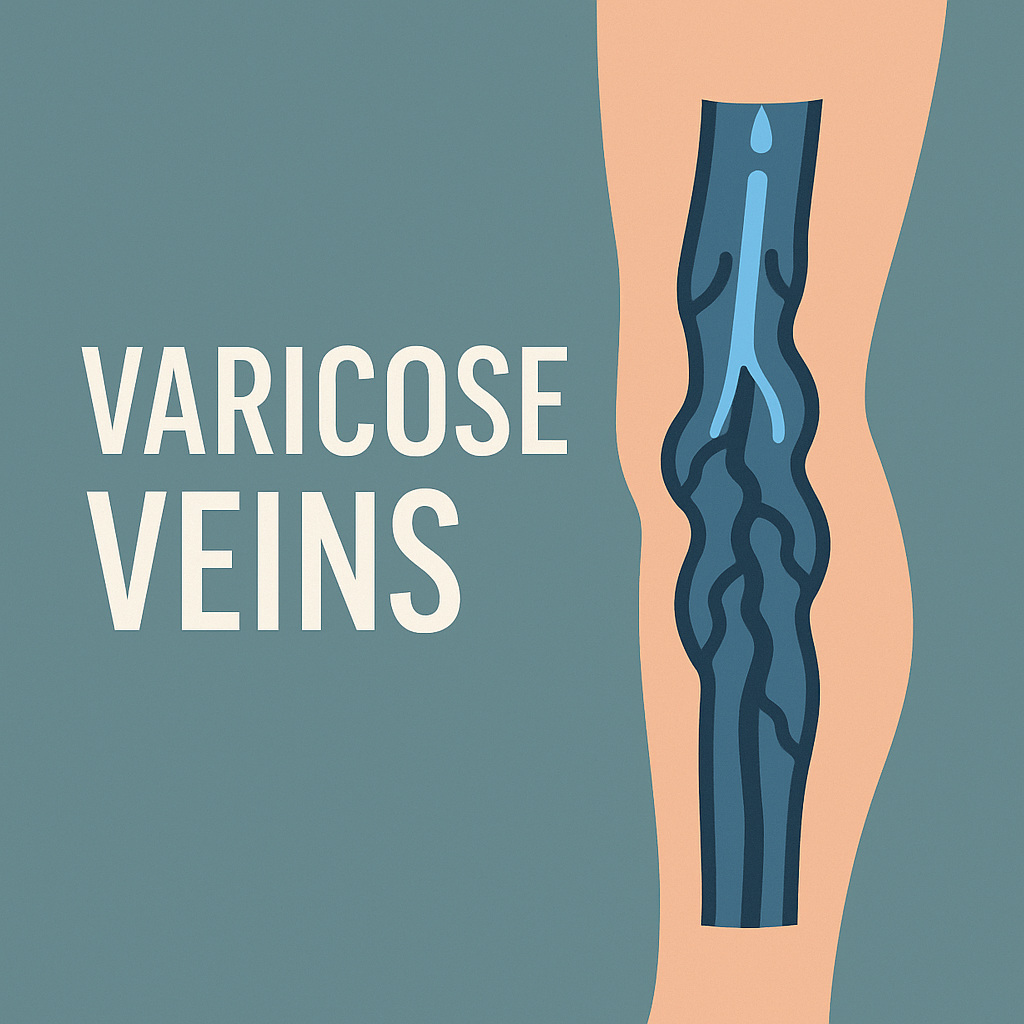Contact us for support
+91 9400799253Blog Details
"Leg Pain, Swelling, and Bulging Veins? Here’s How You Can Treat It"

1. Summary of Key Data and Facts
1.1 Overview of the Condition: Leg Pain, Swelling, and Bulging Veins
- These symptoms are commonly associated with Chronic Venous Insufficiency (CVI) and varicose veins.
- CVI occurs when leg veins fail to efficiently return blood to the heart, causing blood pooling, increased venous pressure, swelling, pain, skin changes, and ulcers.
- Varicose veins are swollen, twisted veins visible under the skin, often causing discomfort, heaviness, and pain.
- Complications include phlebitis (vein inflammation), venous ulcers, and blood clots.
- Risk factors: age, obesity, pregnancy, family history, prolonged standing/sitting, smoking, and previous deep vein thrombosis (DVT).
1.2 Treatment Approaches for Leg Pain, Swelling, and Bulging Veins
- Lifestyle modifications: leg elevation, exercise, weight management, avoiding prolonged standing/sitting.
- Compression therapy: graduated compression stockings to improve venous return and reduce symptoms.
- Medications: venoactive drugs (phlebotonics), anticoagulants, anti-inflammatory agents.
- Minimally invasive procedures: endovenous laser ablation (EVLA), radiofrequency ablation (RFA), sclerotherapy, mechanochemical ablation.
- Surgical options: vein ligation and stripping, ambulatory phlebectomy, subfascial endoscopic perforator surgery (SEPS), vein bypass.
1.3 Composition and Role of the Selected Ingredients
1.3.1 Diosmin (600 mg)
- A flavonoid glycoside derived from citrus fruits.
- Used as a phlebotonic agent to improve venous tone, reduce inflammation, and enhance lymphatic drainage.
- Clinical evidence supports its use in treating CVI symptoms, hemorrhoids, leg ulcers, and varicose veins.
- Studies show diosmin reduces leg pain, swelling, heaviness, and cramps.
- Often combined with hesperidin for enhanced efficacy.
- Dosage: 600 mg once daily is effective; higher doses or micronized forms do not show significant additional benefit.
- Side effects: mild gastrointestinal symptoms, headache, skin reactions; generally well tolerated.
1.3.2 Hesperidin (60 mg)
- A citrus bioflavonoid with antioxidant, anti-inflammatory, and vascular protective properties.
- Enhances venous tone, reduces capillary permeability, and supports microcirculation.
- Used in combination with diosmin for CVI, hemorrhoids, and venous leg ulcers.
- May improve blood pressure and reduce inflammation.
- Dosage: typically 50-150 mg daily in combination with diosmin.
- Side effects: mild gastrointestinal upset; caution with blood thinners and blood pressure medications.
1.3.3 Proanthocyanidin (100 mg)
- A class of polyphenolic flavonoids found in grape seeds, pine bark, and other plants.
- Potent antioxidant and anti-inflammatory effects.
- Supports cardiovascular health by improving blood flow, reducing blood pressure, and protecting capillaries.
- May reduce leg swelling and symptoms of CVI.
- Used for wound healing, skin health, and diabetic complications.
- Dosage: 50-150 mg daily; generally safe with rare mild side effects.
1.3.4 Quercetin 3 Glucuronide (400 mg)
- A metabolite of quercetin, a flavonoid found in many fruits and vegetables.
- Exhibits antioxidant, anti-inflammatory, and anti-rheumatic properties.
- May protect against cartilage degradation and inflammation in osteoarthritis.
- Supports vascular health and may reduce symptoms of CVI.
- Dosage: quercetin supplements typically range from 250-1000 mg daily; glucuronide form has better bioavailability.
- Side effects: generally safe; possible mild gastrointestinal symptoms; interacts with some medications.
1.4 Synergistic Effects and Mechanisms
- Diosmin and hesperidin combination (Micronized Purified Flavonoid Fraction - MPFF) shows synergistic effects in improving venous tone, reducing inflammation, and enhancing lymphatic drainage.
- Proanthocyanidins and quercetin contribute antioxidant and anti-inflammatory effects, protecting blood vessels and connective tissue.
- Quercetin 3 glucuronide inhibits NF-κB pathway and activates Nrf2 pathway, reducing inflammation and extracellular matrix degradation in chondrocytes (relevant for joint health).
- The combination targets multiple pathways involved in venous insufficiency, inflammation, oxidative stress, and tissue repair.
2. Insights and Trends Identified
- Clinical Evidence Supports Diosmin + Hesperidin: Multiple randomized controlled trials show that diosmin 600 mg combined with hesperidin 60 mg effectively reduces symptoms of CVI and hemorrhoids with good safety profiles.
- Proanthocyanidins as Adjuncts: Grape seed extract rich in proanthocyanidins is increasingly recognized for its role in reducing leg swelling, improving blood flow, and protecting capillaries, complementing diosmin and hesperidin.
- Quercetin 3 Glucuronide for Joint and Vascular Health: Emerging research highlights the role of quercetin metabolites in reducing inflammation and cartilage degradation, suggesting benefits beyond vascular symptoms, potentially improving quality of life in patients with joint pain related to venous disease.
- Nanoformulations and Bioavailability: Advances in nanoformulations improve the solubility and bioavailability of flavonoids like quercetin, enhancing their therapeutic potential.
- Multimodal Treatment Approach: Combining these flavonoids targets venous tone, inflammation, oxidative stress, and tissue repair, offering a comprehensive approach to managing leg pain, swelling, and bulging veins.
- Safety and Drug Interactions: While generally safe, these compounds may interact with blood thinners, blood pressure medications, and other drugs metabolized by liver enzymes; medical supervision is advised.
3. Credible Sources and References
- Wikipedia - Diosmin: https://en.wikipedia.org/wiki/Diosmin
- Healthline - Diosmin: https://www.healthline.com/nutrition/diosmin
- RxList - Diosmin: https://www.rxlist.com/supplements/diosmin.htm
- NCBI PMC - Potential and Therapeutic Roles of Diosmin in Human Diseases: https://www.ncbi.nlm.nih.gov/pmc/articles/PMC91385...
- Medicover Hospitals - Diosmin: https://www.medicoverhospitals.in/medicine/diosmin
- NCBI PMC - Antihyperalgesic Effect of Hesperidin Improves with Diosmin in Experimental Neuropathic Pain: https://www.ncbi.nlm.nih.gov/pmc/articles/PMC50318...
- WebMD - Hesperidin: https://www.webmd.com/vitamins/ai/ingredientmono-1...
- Healthline - Hesperidin: https://draxe.com/nutrition/hesperidin/
- NCBI PMC - Is There a Difference in the Clinical Efficacy of Diosmin and Micronized Purified Flavonoid Fraction for the Treatment of Chronic Venous Disorders? https://www.ncbi.nlm.nih.gov/pmc/articles/PMC84551...
- Medical News Today - Grape Seed Extract Benefits: https://www.medicalnewstoday.com/articles/263332
- EBSCO Research Starters - Oligomeric Proanthocyanidins' Therapeutic Uses: https://www.ebsco.com/research-starters/health-and...
- WebMD - Quercetin: https://www.webmd.com/vitamins/ai/ingredientmono-2...
- Healthline - Quercetin: https://www.healthline.com/nutrition/quercetin
- NCBI PMC - Quercetin-3-O-β-D-glucuronide attenuates osteoarthritis by inhibiting cartilage extracellular matrix degradation and inflammation: https://www.ncbi.nlm.nih.gov/pmc/articles/PMC11004...
- Mayo Clinic - Varicose Veins: https://www.mayoclinic.org/diseases-conditions/var...
- Cleveland Clinic - Chronic Venous Insufficiency: https://my.clevelandclinic.org/health/diseases/168...
- Johns Hopkins Medicine - Chronic Venous Insufficiency: https://www.hopkinsmedicine.org/health/conditions-...
- NHS - Phlebitis: https://www.nhs.uk/conditions/phlebitis/
- Progressive Spine & Sports Medicine - What to Do About Painful, Bulging Veins: https://www.progressivespineandsports.com/blog/wha...
- Fox Valley Surgical Specialists - Tips for Varicose Vein Pain Relief: https://foxvalleysurgical.com/tips-for-varicose-ve...

